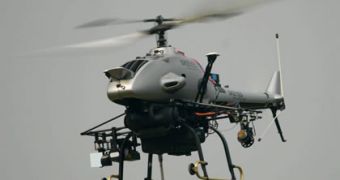It has always been difficult for any kind of flying machine to fly close to the ground in crowded environment conditions, meaning close to buildings, pillars, trees or cables. But a group of technicians from the Carnegie Mellon University in Pittsburgh led by roboticist Sanjiv Singh have managed to build an uncrewed aerial vehicle (UAV) capable to perform low-flight operations and detect any possible obstacles in due time.
Since the majority of the existing UAVs don't possess this feature, the experts have thought of adapting such a commercial civilian craft built by Yamaha and training it so that it would recognize potential threats to its low-level flight. The successful detection of objects located 150 meters ahead of the 3.5-meter long helicopter is mainly due to its custom-built 3D laser scanner that covers a large oval area. The potentially hazardous obstacles it detects are transmitted to a software that recalculates an alternative route for the craft.
Besides the scanner, the avoidance technology also relies on a predetermined long-distance course established with the help of an existing 3D map. This can be preloaded or elaborated by the helicopter during its exploration of a new zone, and it helps the UAV devise a rough route that will bypass obstacles. The scanner only fine-tunes the course, allowing the craft to detect and sidestep 6-millimeter thick cables and pass them by from a safe distance of 3 meters.
This system, which is also used in tiny wheeled robotic machines, allows the helicopter to fly as low as 5 to 11 meters at top speeds of 36 km/h, which makes it a great asset during search-and-rescue missions. According to Jean-Christophe Zufferey, an engineer at Swiss Federal Institute of Technology in Lausanne, Switzerland, quoted by NewScientist, this is the only existing large UAV that is capable of such feats. "Trying to get closer to obstacles, to an urban environment, and to people in general is something that is very useful for a range of applications," claims the researcher.

 14 DAY TRIAL //
14 DAY TRIAL //